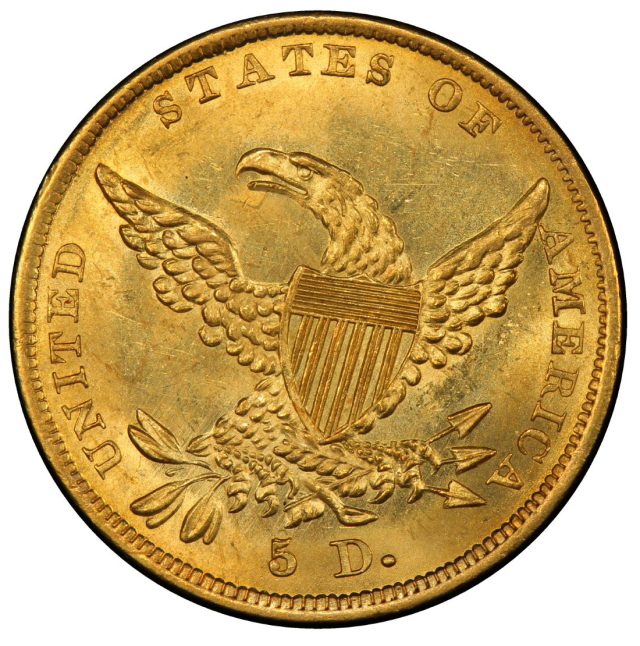USA 5 dollars Classic Head 1838


Rareza
Atributos de las Monedas
| Melt Value | $1,028.48 7.524g Gold |
|---|---|
| Region | USA |
| Denomination | 5 dollars |
| Krause number | KM# 57 |
| Mintage | 286,588 |
| Metal | Gold 0.900 |
| diameter | 22.5 mm |
| weight | 8.36 g |


Introducción de monedas
Mint records indicate that the Philadelphia Mint coined 286,588 half eagles during the year from two die combinations, each with different obverse and reverse dies. Although it cannot be stated with certitude how many of each variety the Mint produced, a likely division is about 175,000 examples of the more common Large Arrows, Small 5 variety and the balance the Small Arrows, Large 5. The present example is the Small Arrows, Large 5 variant, which is considerably rarer than the other variety. In their 2006 Gold Encyclopedia Garrett and Guth comment, 'The typical 1838 half eagle falls into the Extremely Fine to About Uncirculated range, with the largest population bunched at the AU-58 level. In Mint State, the population drops off dramatically and virtually stops at MS-64.?
The Classic Head design dates to August 1834, when the gold content of the quarter eagle and half eagle was reduced. Before that time, our national gold coinage had a melt or gold value that was greater than the face value, so those coins already in circulation were quickly removed and hoarded, or melted, and those who owned gold bullion refused to have it struck into coins. As a result, gold coins from the years before 1834 have become major rarities today. The Classic Head coinage, first struck in August 1834, was an instant success, due simply to the slight weight reduction, from 8.75 grams to 8.31 grams. This change represented a 5% weight reduction and a similar reduction in value from a little over five dollars per coin to a little under five dollars per coin. The Mint Act of June 28, 1834, was the authorizing legislation to reduce the weight of the coins, and was written to take force on August 1. To further enable the populace to readily distinguish the new lower-weight coinage, Mint personnel removed the motto E PLURIBUS UNUM and its scroll from the reverse. The language of the coinage act included a weight reduction for the ten dollar gold eagle, even though such a coin had not been struck for circulation in 30 years. It nonetheless remained a legally authorized denomination, and accordingly had to be included in the new law. The first new ten dollar gold pieces of the lower weight standard would not roll from the mint presses until some four years later, in 1838.
Leer más












